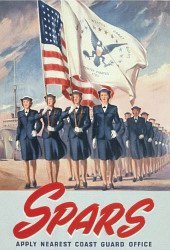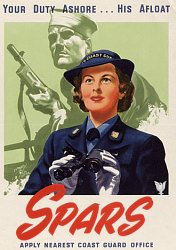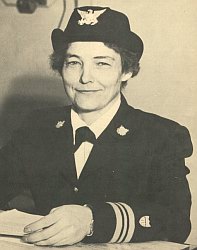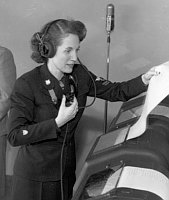Foundation of the SPARS
.
| The United States Congress recognized the
need for female participation in the US Coast Guard for the same basic
reason that it authorized women's reserves for the other branches of the
Armed Services, such as the Army, Navy and Marine Corps - releasing men
for combat.
Capable women trained to perform stateside
military jobs, especially in traditional clerical and routine services,
could perform ordinary duties ashore that allowed reassignment of qualified
Coast Guardsmen aboard warships and cutters at sea. |
.... |
 |
.
 |
.. |
Therefore, on 23 November 1942, President
Roosevelt signed Public Law 773, which modified the previous Coast Guard
Auxiliary and Reserve Act of 1941.
This law authorized women to hold shore positions
(at first restricted to the continental United States but later expanded
overseas) for the duration of the war and for six months thereafter.
The Women's Reserve was thus established as
a branch of the Coast Guard Reserve, but its members required a strong
female leader and a fitting designation for the challenging task ahead. |
.
| The woman selected for the important role
of heading the Coast Guard Women's Reserve was Dorothy C. Stratton, a WAVES
officer whose job in civilian life was Dean of Women at prestigious Purdue
University.
She met the desired credentials of a pioneering
woman professor and strict disciplinarian who oversaw women on a largely
male college campus.
She was promoted to her new post of Director,
and immediately designated the new force of female volunteers as SPARS.
This was her adaptation of the Coast Guard motto, "Semper Paratus" (Always
Ready). |
.... |
 Lieutenant Commander Dorothy
C. Stratton, Director of the SPARS,
Lieutenant Commander Dorothy
C. Stratton, Director of the SPARS,
|
.
At first, the commissioned ranks SPARS officers could attain were
limited. The highest authorized rank of lieutenant commander was held by
the director of the program. The number of lieutenants could not
initially exceed eighteen. Women officers were only allowed to exercise
military authority over female personnel.
.

|
.v |
Captain Stratton was directed to prepare SPARS
immediately to replace servicemen in jobs such as mail clerks, typists,
receptionists, messengers, telephone and teletype operators, radio operators
and technicians, as well as motor vehicle drivers, pharmacist helpers,
cooks and stewards.
Left: SPAR Petty Officer working
as teletype operator
|
.
.
[ I. Development ]..[
II. Facts about the SPARS ]..[
III. Uniforms ]..[
IV. Sources ]
|
